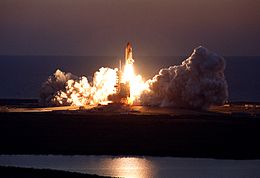STS-102

The launch of STS-102
|
|
| Mission type | ISS crew rotation |
|---|---|
| Operator | NASA |
| COSPAR ID | 2001-010A |
| SATCAT no. | 26718 |
| Mission duration | 12 days, 19 hours, 51 minutes, 57 seconds |
| Distance travelled | 8.5 million kilometres (5.3 million miles) |
| Spacecraft properties | |
| Spacecraft | Space Shuttle Discovery |
| Launch mass | 99,503 kilograms (219,367 lb) |
| Landing mass | 90,043 kilograms (198,511 lb) |
| Payload mass | 5,760 kilograms (12,700 lb) |
| Crew | |
| Crew size | 7 |
| Members |
James D. Wetherbee James M. Kelly Andrew S. W. Thomas Paul W. Richards |
| Launching |
Yury V. Usachev James S. Voss Susan J. Helms |
| Landing |
William M. Shepherd Yuri P. Gidzenko Sergei K. Krikalev |
| EVAs | 2 |
| EVA duration | 15 hours, 17 minutes |
| Start of mission | |
| Launch date | 8 March 2001, 11:42 UTC |
| Launch site | Kennedy LC-39B |
| End of mission | |
| Landing date | 21 March 2001, 07:33:06 UTC |
| Landing site | Kennedy SLF Runway 15 |
| Orbital parameters | |
| Reference system | Geocentric |
| Regime | Low Earth |
| Perigee | 370 kilometres (230 mi) |
| Apogee | 381 kilometres (237 mi) |
| Inclination | 51.5 degrees |
| Period | 92.1 minutes |
| Docking with ISS | |
| Docking port |
PMA-2 (Destiny forward) |
| Docking date | 10 March 2001, 06:38 UTC |
| Undocking date | 19 March 2001, 04:32 UTC |
| Time docked | 8 days, 21 hours, 54 minutes |
 The STS-102 crew portrait. |
|
STS-102 was a Space Shuttle mission to the International Space Station (ISS) flown by Space Shuttle Discovery and launched from Kennedy Space Center, Florida. STS-102 flew in March 2001; its primary objectives were resupplying the ISS and rotating the Expedition 1 and Expedition 2 crews.
Space Station Assembly Flight ISS-5A.1 was the first use of the Multi Purpose Logistics Module (Leonardo) to bring supplies to the station. Also carried an Integrated Cargo Carrier (ICC). The ICC had the External Stowage Platform-1 mounted on its underside. ESP-1 was placed on the port side of 'Destiny' as a storage location for ORUs. The mission also included two spacewalks to relocate the units carried up by the ICC to the Destiny module exterior.
NASA began a tradition of playing music to astronauts during the Gemini program, which was first used to wake up a flight crew during Apollo 15. Each track is specially chosen, often by their families, and usually has a special meaning to an individual member of the crew, or is applicable to their daily activities.
![]() This article incorporates public domain material from websites or documents of the National Aeronautics and Space Administration.
This article incorporates public domain material from websites or documents of the National Aeronautics and Space Administration.
...
Wikipedia

